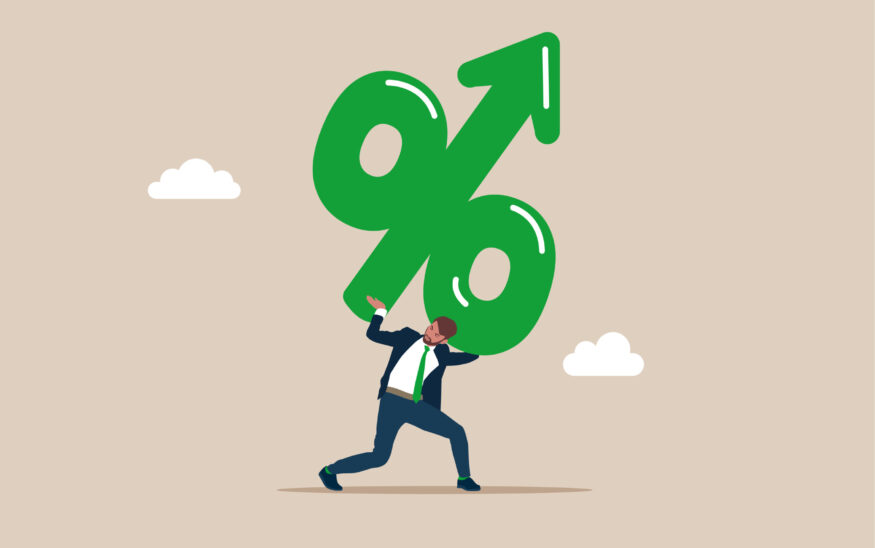Unprecedented Impact of Soaring Interest Rates: What It Means for the Economy
Unraveling the complexities of rising interest rates and their far-reaching implications.
Fred Taylor //October 19, 2023//


Unprecedented Impact of Soaring Interest Rates: What It Means for the Economy
Unraveling the complexities of rising interest rates and their far-reaching implications.
Fred Taylor //October 19, 2023//
You would have to be living on another planet not to feel the deleterious impact of higher interest rates. Just when we thought annus horribilis 2022 was finally in the rear-view mirror, the bond vigilantes have resurfaced to wreak havoc on both stock and bond markets simultaneously.
Since the Federal Reserve has been steadfast in its commitment to get inflation under control, inflation has dropped significantly from 9% to 3%. This is a huge positive, but the negative of these aggressive interest rate increases is starting to be felt everywhere by Americans looking to borrow money. If you haven’t been paying attention, these are the areas where higher rates hurt the most.
READ: Higher Interest Rates — What Does It Mean for Consumers, Bond Investors and the Stock Market?
Home mortgage rates
The latest 30-year mortgage rates have just hit 7.5%, the highest level since 2007. At these levels, first-time home buyers have effectively been shut out of the housing market and have no choice but to rent or live with their parents. So much for the American dream of home ownership.
Moreover, why would anyone move and give up their 3% 30-year mortgage unless they absolutely had to? Many wouldn’t. These factors have caused the inventory of homes on the market to stay low and prices high. Now there is serious talk of 8% 30-year mortgages, which was unheard of just two short years ago. These high rates have a massive impact on the economy; if people aren’t buying or selling homes, they aren’t buying items to fill up these homes, and consumer spending makes up 70% of GDP.
READ: How Do Interest Rates Impact Real Estate Investing?
Variable rate debt
If you have loans that are floating or variable rate, then you better start paying attention to when this debt comes due. Americans got very comfortable with adjustable-rate debt. You might have borrowed money at 2% a few years ago, but that loan will adjust in the next 3-7 years.
The higher new rates could easily double or triple, which means your interest payments could double or triple when these loans readjust. You better have a plan for when that happens. Either save more money to pay these higher interest rates or sell your home or car and rent or lease. Neither option sounds very appealing.
Credit cards, auto loans, margins or lines of credit
If you can’t pay your credit card on time, aren’t paying cash for a new car, or need to borrow on a line of credit or margin, you are in for a rude awakening. These interest rates have skyrocketed.
Interest on credit cards is well over 20%, auto loans are 7%, margin rates typically start at 7.5% and lines of credit loans are approaching 9%. It is incredibly expensive to borrow money for anything. If you don’t need to borrow, don’t. And definitely pay your credit cards on time.
Silver lining
The silver lining with the massive increase in interest rates is that you can finally get paid a decent return on your savings or cash.
READ: Finding the Silver Lining Amidst Rising Interest and Inflation Rates
CDs and short-term treasury bills now pay well over 5%. This is simply a matter of supply and demand. Too much supply and not as much demand. Don’t leave too much money in your checking account at your bank. Move excess cash to a brokerage account. Ask your advisor about rates on CDs and treasury bills. With the Federal Government borrowing more and more money to fund the ever-increasing national deficit, short-term interest could stay higher for longer than expected.
The three major buyers of U.S. debt in the past have been the Federal Reserve, China and Japan. Now, all three have either stopped buying bonds completely or have significantly cut back their purchases, which means new buyers need to emerge to take their place, and now at much higher rates. These new buyers will most likely be institutional or retail investors who like treasury bills at these much higher rates.
It is always darkest before the dawn. When interest rates get too high, consumers stop borrowing. If they stop borrowing, demand dries up, the economy slows, companies stop hiring and may, in some cases, lay off employees to cut costs. This is exactly what the Federal Reserve wants.
The only way to kill inflation is to slow things down dramatically; the only tools it has at its disposal are to stop buying government bonds and keep raising the short-term FED Funds rate. Today, this short-term interest rate is at 5.25-5.50%. Could it go higher? That is the question driving markets these days.
As Fed Chairman Jerome Powell likes to remind us at every press conference, moves in interest rates are data dependent, but rest assured if inflation doesn’t get back to its 2% target, interest rates will remain higher for longer.
Fred Taylor is a Partner, Managing Director at Beacon Pointe Advisors, LLC. The information contained in this article is for general informational purposes only. Opinions referenced are as of the publication date and may be modified due to changes in the market or economic conditions and may not necessarily come to pass. Forward-looking statements cannot be guaranteed. Past performance is not a guarantee of future results. Beacon Pointe has exercised all reasonable professional care in preparing this information. The information has been obtained from sources we believe to be reliable; however, Beacon Pointe has not independently verified or attested to the accuracy or authenticity of the information.


























